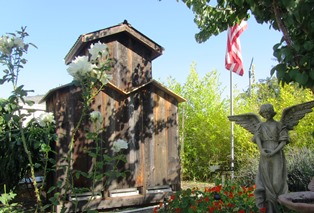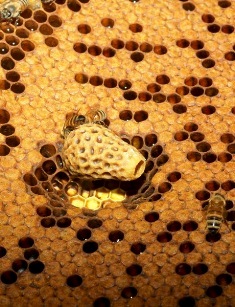Building A Honeybee House
For my birthday this year, my husband surprised me with some practical beekeeping gifts and a promise to build an attractive bee house to hold our hives. In a plastic, five-gallon honey bucket, he’d placed a beekeeper’s suit, goatskin gloves, and a smoker.
This weekend, he made good on his promise. Although the temps hit 85 on Saturday and Sunday, he suited up in a lightweight beekeeper’s topper with protective netting over the face and got to work measuring, cutting, and securing the waterproofing material, hammering it in place.
With the waterproofing material attached to the roof and sides, he then covered the structure with old fence boards. But it wasn’t easy to mark the cut lines wearing gloves much less cutting the boards with the arm and table saws. He peeled the gloves off.

Beekeeper access is through the rear; the upper story holds a supply shelf; bee entrances are at the front bottom
Now, I know one thing about honeybees. Knocking at their door (say, with a hammer) will bring the guards out and they’ll sting . . . which they did.
My husband was on a mission and wasn’t about to let a bee sting stop him. He rubbed the spot with an ice cube, refused to take any Benadry®, and returned to work. But, not before donning some gloves.
But the gloves he put on weren’t beekeeping gloves. They were gardening gloves, good for deadheading roses but not much of a defense against venom-filled stingers.
So, for a little additional insurance against any more bee stings, we lit the smoker to calm the bees a bit. My husband was nearly finished working around the entrance to the hive when one of the honeybees apparently took notice of the fabric portion of the glove and stung right through it.
Even then, Carlos didn’t want to stop working. Only two metal roof sections remained to be cut, placed, and secured along with a shelf for the supplies. But it was sunset. The bees were going in for the night, and we were working in their flight path. We decided to call it a day, too.
The bee house roof will need to be finished before the rainy season starts in November. The good news is that the bees won’t bother Carlos if he stays in back of their house or on the roof. Activity at their front door sends an alarm through the entire colony that a predator is trying to get in. The honeybee defense is to go into attack mode, even if the “predator” in this case is the architect who designed and built their darling little house.
20 Interesting Facts about Honeybees
If your fruit trees, berries, and flowers are flourishing, you can be assured that bees have been busy in your garden. If you are a gardener who lives near a beekeeper, consider yourself really fortunate. Eighty percent of pollination is attributed to bees. Without these industrious little insects, Earth’s plant diversity would be in jeopardy. Here are some other interesting facts about honeybees (apis mellifera).
WORKER HONEYBEES
1. The worker honeybees are sterile females. The workers keep the hive clean, serve as nursemaids to the babies, forage for food, scout for new locations, stand guard at the hive entrance, and care for the queen.
2. The lifespan of a worker bee is 6 to 8 weeks; the queen’s lifespan can stretch to 3 years.
3. In her short lifetime, an average worker bee will produce about 1 1/2 teaspoons of honey.
4. A honeybee will travel about six miles from its hive to forage on nectar- or pollen-rich plants.
5. Honeybees never sleep.
6. During one collection flight, a honeybee will visit between 50 and 100 flowers.
THE QUEEN
7. A honeybee queen is made or created (as opposed to being born). Worker bees secrete royal jelly through the glands in their heads (hypopharynx and mandibular) to feed the larvae. Rich in vitamins and nutrients, the royal jelly may also contain a single protein known as royalactin and scientists believe this ingredient ensures the larva becomes a queen.
8. Newly emerged queens will fight to the death, leaving only one to rule the hive. The honeybee queen lays around 2,000 eggs. These become fully developed in 21 days.
9. The queen doesn’t leave the hive. Her job is to mate with the drones, produce eggs, and serve as matriarch of the colony.
THE DRONES
10. Drones are bigger than the worker bees but smaller than the queen and have rear-ends that are more blunted than round.
11. The drone’s sole purpose is to mate with the queen, which he does in the air. Drones die during mating.
12. Drones do not have stingers unlike the worker bees who have stingers with bee venom.
13. Drones are kicked out of the colony in the autumn when mating season in over because the honey reserves are needed to support the colony’s queen and workers through the winter. The drones are expendable since they don’t forage for food, make honeycomb or honey, care for the babies, clean the hive, or otherwise contribute to the colony.
THE COLONY
14. Honeybees communicate with each other through chemical signals. When there is a predator present, the worker bees release a pherome that communicates to her hive mates the need to attack.
15. The primary swarm (with the old queen) happens in spring and is a colony in transition. Swarming is the method by which the bees leave the hive en masse to establish a new colony. Swarming usually occurs during a two-week period in spring on warm days.
16. A swarm can include 10,000 bees but they are not in attack mode; they are preparing to move to a new home with their queen and are carrying the honey they need for the trip in their stomachs.
17. Honeybee colonies have been around for millions of years. There are fossils of honeybees in European deposits dating back 23 to 56 million years ago.
HONEY
18. Honeybees are the only insects that produce a product that humans eat. Honey is highly nutritious and has many health benefits.
19. Honey never goes bad; honey was found in King Tut’s tomb.
20. It takes more than 500 honeybees collecting pollen from 2 million flowers to make 1 pound of honey.
 Facebook
Facebook Goodreads
Goodreads LinkedIn
LinkedIn Meera Lester
Meera Lester Twitter
Twitter








